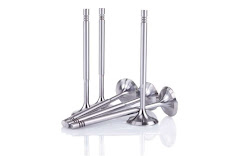This is a blog that provides a detailed overview of what a camshaft and valve are, how they work together to create the power your engine needs, and what makes them suitable for different operations.
What are Camshafts and Valves
A camshaft is nothing more than a shaft onto which cams are mounted. In most in-line engines, the camshaft is attached to a bearing located in the bottom portion of the cylinder block. It is located on the top of the cylinder head in certain engines.
The rotating motion of the camshaft is converted into the linear motion of the follower or filter via a cam. The cams each have a lobe or high point on them. The follower mounted on the cams will either move farther away or closer to the camshaft as the cam rotates. A camshaft opens the valves in an internal combustion engine. Along with its length, a camshaft will have several cams on it. There will be two cams for each cylinder: one cam will operate the intake valve, and the other will move the exhaust valve.
The Working of Camshafts
The camshafts are designed to spin in unison with the engine. The cam is linked to the spinning camshaft, where it is then installed, and the follower is attached to the cam. The follower exerts a force on the connecting rod or rocker arm, bringing the valves closer together. The amount of force exerted by the follower is determined by the profile or form of the cam. This allows the cylinder head to be opened, allowing combustion products to escape the engine while allowing new air to enter. The spring is an element that plays a very significant role in this construction.
After the valves have been pressed down, this spring makes it possible for them to go back to their original position in a short amount of time. Because of the spring's high level of stiffness, the valve may be immediately closed, which is essential to avoid experiencing a drop in power following the intake stroke. Suppose the valves are allowed to stay open for a significant time. In that case, the compression stroke will be negatively impacted, and the cycle as a whole will operate less effectively.
The Classification of Camshafts
Managing the airflow at both the intake and the exhaust is almost entirely responsible for determining these characteristics. Depending on this, the engine's emissions, power, and torque outputs, as well as the engine's efficiency, will all be influenced. As a result of the prevalence of electronic controls in modern machinery, having a cam system that is quick to react is of the highest significance. As a direct consequence, a wide variety of cam profiles have been developed so that the Variable Valve Timing and Lift system may provide a degree of adaptability. Cam profiles have the potential to be switches that allow the duration and lift of the valves to be regulated, and this potential may vary depending on the needs of the driver.
Conclusion
For further information about camshafts and valves, please get in touch with Garima Global, which is recognised as one of the leading camshaft manufacturing companies in India.


Comments
Post a Comment